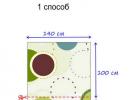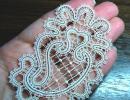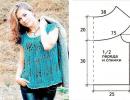Knitting a women's hat on knitting needles with large braid. How to knit a hat using the Braided pattern: diagram with description. Knitting is carried out according to this principle
 how to knit beautifully?
how to knit beautifully?
The pattern is simple, thanks to it the hat is very warm, double, holds its shape perfectly and creates volume. And so, the first thing you need to decide on is the style. What type of hat suits you? On the head or a little more curvy? Or does he take it at all? The number of increases after the elastic band will depend on this. The braid can be different: 2 by 2 (cross of 4 loops, pattern is a multiple of 4), 3 by 3 (cross of 6 loops, pattern is a multiple of 6), 4 by 4 and so on. Here is a standard 3 by 3 braid pattern. Don’t forget, if we knit on circular needles, there are no edge needles, i.e. the pattern is simply a multiple of 6 in the case of 3 by 3 braid knitting.
We choose the yarn, based on this choice, we also choose the type of braid. Let's say here the yarn is Nako Arctic 100 grams/100 meters, the braid is 4 by 4. This model is Harmony yarn... like Vita. Braided 4 by 4. Model on the head. This Lanagold 800 in 4 threads, knitted with a gradient, 6 by 6 braid, double elastic. Have you decided on the model and yarn? Then we move on to knitting samples. We need 2 samples: the pattern itself and the elastic band. We measure and calculate the knitting density in samples. When casting on loops, we focus on the elastic pattern! The “Braided” pattern tightens the fabric very tightly, so after the elastic it is necessary to make increases, even if the hat is on the head. And if you want fluffy hat, there will be a lot of increases. Now I will explain the principle using the example of the first, black, hat. So, yarn Nako Arctic 100/100, OG 56 cm. It took a little less than 200 grams. We cast on 96 loops, knit on circular needles No. 5 (40 cm knitting needles) a 2 by 2 elastic band (knit 2, purl 2). Here, be guided by your taste, my elastic band is usually 7 cm. Next, we begin to increase. Increase in any convenient way: either we pull a loop from a crossed broach, or we knit 2 loops from one, see for yourself.
If we want a hat on the head: we make increases every 3 loops.
If we want a fuller hat: we make increases every 2 loops! That is: 2 knits, increase, 2 knits, increase. This is exactly our case. As a result, we have 144 loops on our knitting needles.
If we want it even more magnificent, then there is an increase through each loop; if we knit a take, then we knit 2 from each loop!
We knit several front rows (5-6, not important), move on to the pattern.
- * We leave 4 loops on an additional knitting needle before work, knit 4 loops, then knit the loops from an additional knitting needle * and so on until the end of the row. (Be sure to mark the first stitch of the row with a marker!)
- 6 rows with knits
— 4 knit stitches * leave 4 loops on an additional knitting needle while working, knit 4 loops, then knit loops from an additional knitting needle * repeat until the end of the row (do not forget to mark the first loop of the row with a marker)
Knit 6 rows again. That is, we have a cross in every 7th row.
So we knit to the desired depth. We will start decreasing somewhere 4-5 cm before the end of the cap, keep this in mind.
Decrements: after the last cross completed, knit 1 row. In the next row we will start decreasing.
1. We knit loops 2 together in those places where we have loops at the bottom of the cross, that is, it turns out:
*Knit 4, purl 2 together, purl 2*.
2. *Knit 4, purl, purl 2 together*
3. *Knit 4, purl 2 together*
4. *Knit 2, purl 2 together, purl 1*
5. *knit 2, purl 2 together*
6. *knit all 2 stitches together”, continue until there are 20 stitches left on the knitting needles.
Break the thread, thread it through a needle for sewing knitted items, thread the thread through the remaining open loops, pull it off, then pass the needle through these loops one more time and pull it off again.
Well, decorate it to your liking.
When the cold weather comes, everyone strives to quickly warm up, but at the same time look beautiful and fashionable. For several years now, hats with various patterns have remained in fashion. Beautiful designs change and improve every year, and therefore it is sometimes difficult to keep track of trends. But basically the patterns come from ordinary braids, where you need to know how to make a binding. It's not difficult, but you need to have patience and be careful. A hat with a braided pattern is very easy to knit, but at the same time it looks beautiful, rich and is quite warm.
Even someone who is just starting to knit can handle this pattern. At first glance, it may seem that such drawings are complicated due to their binding, but if the scheme is described in detail and the beginner sticks to it, then the result will be excellent.

Decorate with a fur pompom
The braided hat is very beautiful and light, but at the same time keeps you warm. Due to this pattern, the product holds its shape for a long time and at the same time appears more voluminous. In this master class we will look in detail at how to knit a hat with a weaving pattern, and with a description the task will seem easy and even a beginner will be able to cope with it.
What we need to prepare:
- thread "Pechorda" 50 g;
- knitting needles number 4 and 6;
Now let's start knitting. To do this, we cast on 120 buttonholes and 2 more edge buttonholes on the knitting needles, it should be 56 cm if knitted double elastic band. 1st row: you need to remove the edge buttonhole, * front buttonhole, remove one buttonhole without knitting it, purl, remove another one * but the edge buttonhole should be knitted purlwise.
2nd row: remove the edge buttonhole, * front buttonhole, one must be removed without knitting, purl, remove the next one and not knit it * - repeat this until the very end of the row. Again, knit the edge purl.
It is important that in this row it is necessary to knit those buttonholes that we did not knit in the first one. The height of the elastic band should be 6 cm.

Now we switch to number 6 knitting needles, which we will use to knit the pattern. Once the elastic is knitted, we add 12 more buttonholes for a total of 134 buttonholes. Let's start knitting the pattern.
1st row: we knit with only front buttonholes. 2nd row: now we knit with purls. Next, we knit the 3rd-5th rows with knit stitches, and knit the 4th and 6th rows with purl stitches. 7th row: knit the edge buttonhole, * transfer 4 buttonholes to an additional needle and leave them in front of the product, then 4 knit buttonholes, after the 4 buttonholes that were transferred, you need to knit them with knit buttonholes. 8th row: knit purl stitches. 9th row: we knit the front buttonholes.

Now we alternate rows up to 12. Already from the 13th row we need to start everything from the first row. We make a row of elastic 2 by 2. This will make 13 cm. Next we need to make decreases after the pattern: knit 2 knits, purl, now we combine two buttonholes, only knit purl. Elastic band again, height 1 cm and decrease the buttonholes: we knit all the purl buttonholes, two together, but after a row we combine the two front buttonholes, and on the next row we knit them on the front side, we knit two together through one buttonhole. The decrease continues for 5 cm. We pass the remaining buttonholes through the thread and tighten them, and pull the remaining thread to the wrong side. Then we take a fur pompom and sew it to the hat, and now our product is ready, you can wear it.
According to fashion trends
This hat is very fashionable, in addition, the designers assure that this model will also be in trend this winter. Usually branded items cost big money, so many needlewomen, saving their money, knit such things on their own. Things you make yourself are more valuable, especially since you can add something of your own, then such a headdress will become completely unique.

What you need to prepare:
- semi-woolen threads;
- knitting needles number 4 and an additional knitting needle;
- scissors;
- needle.
For a head circumference of 56-58, cast on 70 buttonholes on circular knitting needles. Now we knit a regular elastic band 2 by 2 14 rows. When the elastic band is knitted, we must knit 3 rows of knit buttonholes, while adding 24 loops. The pattern below shows the knitting pattern for the pattern. In this case, we remove three buttonholes onto an additional knitting needle in front of the product. We knit three loops, and then we knit three buttonholes from an additional knitting needle. And so we knit the entire row. Next, we knit 5 rows with facial buttonholes. And then we make the binding on the other side.






After the second crossing, the pattern will become clearer. And so we knit to the required height, approximately 15 cm. And only then we begin to make decreases. During the binding period, using an additional knitting needle, we make a reduction behind the product. And after 5 rows you need to remove them from the main fabric. After that we knit a few more rows, and then knit 2 buttonholes together for 5 rows. At the moment when there are only 12-18 buttonholes, use a thread to tighten everything and pull the remaining thread inside the hat. All that remains is to sew the hat with the same thread, and everything is ready.
When the cold weather comes, everyone strives to quickly warm up, but at the same time look beautiful and fashionable. For several years now, hats with various patterns have remained in fashion. Beautiful designs change and improve every year, and therefore it is sometimes difficult to keep track of trends. But basically the patterns come from ordinary braids, where you need to know how to make a binding. It's not difficult, but you need to have patience and be careful. A hat with a braided pattern is very easy to knit, but at the same time it looks beautiful, rich and is quite warm.
Even someone who is just starting to knit can handle this pattern. At first glance, it may seem that such drawings are complicated due to their binding, but if the scheme is described in detail and the beginner sticks to it, then the result will be excellent.

Decorate with a fur pompom
The braided hat is very beautiful and light, but at the same time keeps you warm. Due to this pattern, the product holds its shape for a long time and at the same time appears more voluminous. In this master class we will look in detail at how to knit a hat with a weaving pattern, and with a description the task will seem easy and even a beginner will be able to cope with it.
What we need to prepare:
- thread "Pechorda" 50 g;
- knitting needles number 4 and 6;
Now let's start knitting. To do this, we cast on 120 buttonholes and 2 more edge buttonholes on the knitting needles, it should be 56 cm if you knit a double elastic band. 1st row: you need to remove the edge buttonhole, * front buttonhole, remove one buttonhole without knitting it, purl, remove another one * but the edge buttonhole should be knitted purlwise.
2nd row: remove the edge buttonhole, * front buttonhole, one must be removed without knitting, purl, remove the next one and not knit it * - repeat this until the very end of the row. Again, knit the edge purl.
It is important that in this row it is necessary to knit those buttonholes that we did not knit in the first one. The height of the elastic band should be 6 cm.

Now we switch to number 6 knitting needles, which we will use to knit the pattern. Once the elastic is knitted, we add 12 more buttonholes for a total of 134 buttonholes. Let's start knitting the pattern.
1st row: we knit with only front buttonholes. 2nd row: now we knit with purls. Next, we knit the 3rd-5th rows with knit stitches, and knit the 4th and 6th rows with purl stitches. 7th row: knit the edge buttonhole, * transfer 4 buttonholes to an additional needle and leave them in front of the product, then 4 knit buttonholes, after the 4 buttonholes that were transferred, you need to knit them with knit buttonholes. 8th row: knit purl stitches. 9th row: we knit the front buttonholes.

Now we alternate rows up to 12. Already from the 13th row we need to start everything from the first row. We make a row of elastic 2 by 2. This will make 13 cm. Next we need to make decreases after the pattern: knit 2 knits, purl, now we combine two buttonholes, only knit purl. Elastic band again, height 1 cm and decrease the buttonholes: we knit all the purl buttonholes, two together, but after a row we combine the two front buttonholes, and on the next row we knit them on the front side, we knit two together through one buttonhole. The decrease continues for 5 cm. We pass the remaining buttonholes through the thread and tighten them, and pull the remaining thread to the wrong side. Then we take a fur pompom and sew it to the hat, and now our product is ready, you can wear it.
According to fashion trends
This hat is very fashionable, in addition, the designers assure that this model will also be in trend this winter. Usually branded items cost a lot of money, so many needlewomen, saving their money, knit such items themselves. Things you make yourself are more valuable, especially since you can add something of your own, then such a headdress will become completely unique.

What you need to prepare:
- semi-woolen threads;
- knitting needles number 4 and an additional knitting needle;
- scissors;
- needle.
For a head circumference of 56-58, cast on 70 buttonholes on circular knitting needles. Now we knit a regular elastic band 2 by 2 14 rows. When the elastic band is knitted, we must knit 3 rows of knit buttonholes, while adding 24 loops. The pattern below shows the knitting pattern for the pattern. In this case, we remove three buttonholes onto an additional knitting needle in front of the product. We knit three loops, and then we knit three buttonholes from an additional knitting needle. And so we knit the entire row. Next, we knit 5 rows with facial buttonholes. And then we make the binding on the other side.






After the second crossing, the pattern will become clearer. And so we knit to the required height, approximately 15 cm. And only then we begin to make decreases. During the binding period, using an additional knitting needle, we make a reduction behind the product. And after 5 rows you need to remove them from the main fabric. After that we knit a few more rows, and then knit 2 buttonholes together for 5 rows. At the moment when there are only 12-18 buttonholes, use a thread to tighten everything and pull the remaining thread inside the hat. All that remains is to sew the hat with the same thread, and everything is ready.






Video on the topic of the article
This article presents videos with which you can learn how to knit. beautiful hat with a braided pattern.
Hello everyone As promised, I’m posting a description of the braided hat and some tips and tricks for knitting it.
The pattern is simple, thanks to it the hat is very warm, double, holds its shape perfectly and creates volume.
And so, the first thing you need to decide on is the style. What type of hat suits you? On the head or a little more curvy? Or does he take it at all?
The number of increases after the elastic band will depend on this
The braid can be different: 2 by 2 (cross of 4 loops, pattern is a multiple of 4), 3 by 3 (cross of 6 loops, pattern is a multiple of 6), 4 by 4 and so on.
Here is a standard 3 by 3 braid pattern. Don’t forget, if we knit on circular needles, there are no edge needles, i.e. the pattern is simply a multiple of 6 in the case of 3 by 3 braid knitting.
We choose the yarn, based on this choice, we also choose the type of braid.
Let's say here the yarn is Nako Arctic 100 grams/100 meters, the braid is 4 by 4. 


This model is Harmony yarn... kind of like Vita. Braided 4 by 4. Model on the head. 



This Lanagold 800 in 4 threads, knitted with a gradient, 6 by 6 braid, double elastic.


Have you decided on the model and yarn? Then we move on to knitting samples. We need 2 samples: the pattern itself and the elastic band.
We measure and calculate the knitting density in samples. When casting on loops, we focus on the elastic pattern!
The "Braid" pattern tightens the fabric very tightly, so after the elastic it is necessary to make increases, even if the hat is on the head. And if you want a fluffy hat, there will be a lot of extras.
Now I will explain the principle using the example of the first, black, hat.
So, yarn Nako Arctic 100/100, OG 56 cm. It took a little less than 200 grams.
We cast on 96 loops, knit on circular needles No. 5 (40 cm knitting needles) a 2 by 2 elastic band (knit 2, purl 2). Here, be guided by your taste, my elastic band is usually 7 cm. Next, we begin to increase. Increase in any convenient way: either we pull a loop from a crossed broach, or we knit 2 loops from one, see for yourself.
If we want a hat on the head: we make increases every 3 loops.
If we want a fuller hat: we make increases every 2 loops! That is: 2 knits, increase, 2 knits, increase. This is exactly our case. As a result, we have 144 loops on our knitting needles.
If we want it even more magnificent, then there is an increase through each loop; if we knit a take, then we knit 2 from each loop!
We knit several front rows (5-6, not important), move on to the pattern.
- * We leave 4 loops on an additional knitting needle before work, knit 4 loops, then knit the loops from an additional knitting needle * and so on until the end of the row. (Be sure to mark the first stitch of the row with a marker!)
- 6 rows knit
- knit 4 loops * leave 4 loops on an additional knitting needle while working, knit 4 loops, then knit loops from an additional knitting needle * repeat until the end of the row (do not forget to mark the first loop of the row with a marker)
Knit 6 rows again. That is, we have a cross in every 7th row.
So we knit to the desired depth. We will start decreasing somewhere 4-5 cm before the end of the cap, keep this in mind.
Decrements: after the last cross completed, knit 1 row. In the next row we will start decreasing.
1. We knit loops 2 together in those places where we have loops at the bottom of the cross, that is, it turns out:
*Knit 4, purl 2 together, purl 2*.
2. *Knit 4, purl, purl 2 together*
3. *Knit 4, purl 2 together*
4. *Knit 2, purl 2 together, purl 1*
5. *knit 2, purl 2 together*
6. *knit all 2 stitches together”, continue until there are 20 stitches left on the needles.
Break the thread, thread it through a needle for sewing knitted items, thread the thread through the remaining open loops, pull it off, then pass the needle through these loops one more time and pull it off again.
Well, decorate it to your liking.
Thank you all for your attention
There are descriptions of some other types of braided hats in my previous publications.
If you want to follow the publications, you are welcome to become a friend, I will be glad.
Publication of photographs, articles or parts of them is permitted only with reference to the original source (c)
Details about the hat with the "Braided" pattern. Hello everyone. As promised, I am posting a description of the braided hat and some tips and tricks for knitting it. The pattern is simple, thanks to it the hat is very warm, double, holds its shape perfectly and creates volume. And so, the first thing you need to decide on is the style. What type of hat suits you? On the head or a little more curvy? Or does he take it at all? The number of increases after the elastic will depend on this. The braid can be different: 2 by 2 (cross of 4 loops, pattern is a multiple of 4), 3 by 3 (cross of 6 loops, pattern is a multiple of 6), 4 by 4 and so on. Here is a standard 3 by 3 braid pattern. Don’t forget, if we knit on circular knitting needles, there are no edges, i.e. the pattern is simply a multiple of 6 in the case of 3 by 3 braid knitting. We choose the yarn, based on this choice, we also choose the type braids. Let's say here the yarn is Nako Arctic 100 grams/100 meters, the braid is 4 by 4. This model is Harmony yarn... like Vita. Braided 4 by 4. Model on the head. This Lanagold 800 in 4 threads, knitted with a gradient, 6 by 6 braid, double elastic. Have you decided on the model and yarn? Then we move on to knitting samples. We need 2 samples: the pattern itself and the elastic band. We measure and calculate the knitting density in samples. When casting on loops, we focus on the elastic pattern! The "Braid" pattern tightens the fabric very tightly, so after the elastic it is necessary to make increases, even if the hat is on the head. And if you want a fluffy hat, there will be a lot of extras. Now I will explain the principle using the example of the first, black, hat. So, yarn Nako Arctic 100/100, OG 56 cm. It took a little less than 200 grams. We cast on 96 loops, knit on circular needles No. 5 (40 cm knitting needles) a 2 by 2 elastic band (knit 2, purl 2). Here, be guided by your taste, my elastic band is usually 7 cm. Next, we begin to increase. Increase in any convenient way: either we pull a loop from a crossed broach, or we knit 2 loops from one, see for yourself. If we want a hat on the head: we make increases every 3 loops. If we want a fuller hat: we make increases every 2 loops! That is: 2 knits, increase, 2 knits, increase. This is exactly our case. As a result, we have 144 loops on our knitting needles. If we want it even more magnificent, then there is an increase through each loop; if we knit a take, then we knit 2 from each loop! We knit several front rows (5-6, not important), move on to the pattern. - * We leave 4 loops on the additional knitting needle before work, knit 4 loops, then knit the loops from the additional knitting needle * and so on until the end of the row. (be sure to mark the first loop of the row with a marker!) - 6 rows with knit stitches - 4 knit stitches * leave 4 loops on an additional knitting needle while working, knit 4 loops with knit stitches, then knit stitches from an additional knitting needle * repeat until the end of the row (do not forget to mark the first one with a marker stitch row) Knit 6 rows again. That is, we have a cross in every 7th row. So we knit to the desired depth. We will start decreasing somewhere 4-5 cm before the end of the cap, keep this in mind. Decrements: after the last cross completed, knit 1 row. In the next row we will start decreasing. 1. We knit loops 2 together in those places where we have loops at the bottom of the cross, that is, it turns out: *4 knit, 2 purl together, 2 purl*. 2. *knit 4, purl 2 together, purl 2* 3. *knit 4, purl 2 together* 4. *knit 2, purl 2 together, purl 1* 5. *knit 2, purl 2 together* 6. *knit all stitches 2 together”, continue this way until there are no stitches left on the knitting needles 20. Break the thread, thread it through a needle for sewing knitted items, thread the thread into the open remaining loops, pull it off, then go through these loops again with the needle and again pull it off. Well, and design it to your liking. Thank you all for your attention. There are descriptions of some more types of wicker hats in my previous publications. If you want to follow the publications, you are welcome to be my friend.






